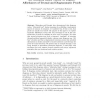Free Online Productivity Tools
i2Speak
i2Symbol
i2OCR
iTex2Img
iWeb2Print
iWeb2Shot
i2Type
iPdf2Split
iPdf2Merge
i2Bopomofo
i2Arabic
i2Style
i2Image
i2PDF
iLatex2Rtf
Sci2ools
DIAGRAMS
2010
Springer
2010
Springer
An Attention Based Theory to Explore Affordances of Textual and Diagrammatic Proofs
Shimojima and Katagiri have demonstrated that diagrams reduce "inferential load" during reasoning by scaffolding visual-spatial aspects of memory. In response, we wondered why, if this is true, that proofs are usually text based? The purpose of this paper is to explore ergonomic affordances of text that may encourage its use in the communication of proofs by building on prior work in attention. We claim that textual notations may focus a reasoner's "spotlight" of attention through serialized sequential chunks, whereas many diagrams may "diffuse" attention and that a diagrammatic notation system that serialized information in chunks amenable to focused attention could leverage the power of textual notations. We present such an example through a case study focused on generalized constraint diagrams, a visual logic with attributes that may support focused attention and extract ergonomic principles that may transcend each notation system. Key words: atten...
Artificial Intelligence | DIAGRAMS 2010 | Focused Attention | Inferential Load | Textual Notations |
| Added | 08 Nov 2010 |
| Updated | 08 Nov 2010 |
| Type | Conference |
| Year | 2010 |
| Where | DIAGRAMS |
| Authors | Peter Coppin, Jim Burton, Stephen Hockema |
Comments (0)

